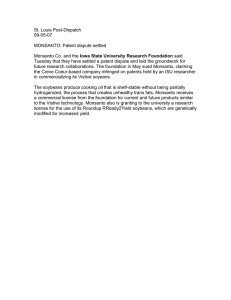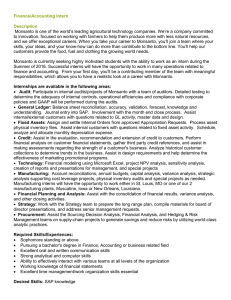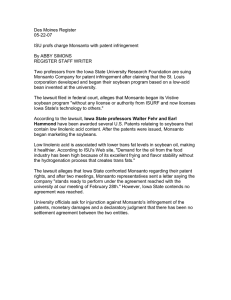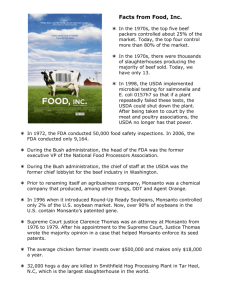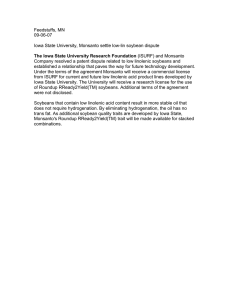REPLICATION, INTEGRATION, DEDICATION Jeremy N. Sheff
advertisement
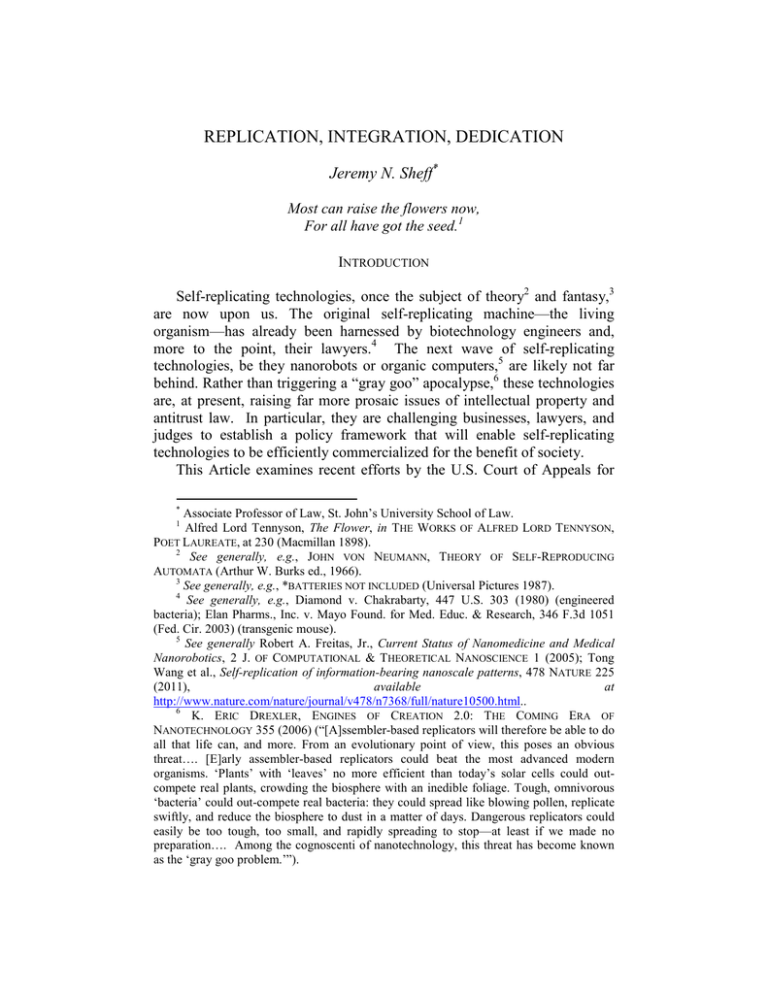
REPLICATION, INTEGRATION, DEDICATION Jeremy N. Sheff* Most can raise the flowers now, For all have got the seed.1 INTRODUCTION Self-replicating technologies, once the subject of theory2 and fantasy,3 are now upon us. The original self-replicating machine—the living organism—has already been harnessed by biotechnology engineers and, more to the point, their lawyers.4 The next wave of self-replicating technologies, be they nanorobots or organic computers,5 are likely not far behind. Rather than triggering a “gray goo” apocalypse,6 these technologies are, at present, raising far more prosaic issues of intellectual property and antitrust law. In particular, they are challenging businesses, lawyers, and judges to establish a policy framework that will enable self-replicating technologies to be efficiently commercialized for the benefit of society. This Article examines recent efforts by the U.S. Court of Appeals for * Associate Professor of Law, St. John’s University School of Law. Alfred Lord Tennyson, The Flower, in THE WORKS OF ALFRED LORD TENNYSON, POET LAUREATE, at 230 (Macmillan 1898). 2 See generally, e.g., JOHN VON NEUMANN, THEORY OF SELF-REPRODUCING AUTOMATA (Arthur W. Burks ed., 1966). 3 See generally, e.g., *BATTERIES NOT INCLUDED (Universal Pictures 1987). 4 See generally, e.g., Diamond v. Chakrabarty, 447 U.S. 303 (1980) (engineered bacteria); Elan Pharms., Inc. v. Mayo Found. for Med. Educ. & Research, 346 F.3d 1051 (Fed. Cir. 2003) (transgenic mouse). 5 See generally Robert A. Freitas, Jr., Current Status of Nanomedicine and Medical Nanorobotics, 2 J. OF COMPUTATIONAL & THEORETICAL NANOSCIENCE 1 (2005); Tong Wang et al., Self-replication of information-bearing nanoscale patterns, 478 NATURE 225 (2011), available at http://www.nature.com/nature/journal/v478/n7368/full/nature10500.html.. 6 K. ERIC DREXLER, ENGINES OF CREATION 2.0: THE COMING ERA OF NANOTECHNOLOGY 355 (2006) (“[A]ssembler-based replicators will therefore be able to do all that life can, and more. From an evolutionary point of view, this poses an obvious threat…. [E]arly assembler-based replicators could beat the most advanced modern organisms. ‘Plants’ with ‘leaves’ no more efficient than today’s solar cells could outcompete real plants, crowding the biosphere with an inedible foliage. Tough, omnivorous ‘bacteria’ could out-compete real bacteria: they could spread like blowing pollen, replicate swiftly, and reduce the biosphere to dust in a matter of days. Dangerous replicators could easily be too tough, too small, and rapidly spreading to stop—at least if we made no preparation…. Among the cognoscenti of nanotechnology, this threat has become known as the ‘gray goo problem.’”). 1 2 REPLICATION, INTEGRATION, DEDICATION [17-Nov-11 the Federal Circuit to deal with the leading edge of this policy challenge in cases involving the paradigmatic self-replicating technology: the seed. In a series of cases involving Monsanto’s “Roundup-Ready” herbicide-resistant seed technology, the U.S. Court of Appeals for the Federal Circuit has sharply limited the applicability of various defenses to patent liability grounded in antitrust principles.7 To justify its holdings, the Federal Circuit has warned that the only alternative would be to “eviscerate” Monsanto’s patents.8 The Monsanto decisions offer a useful case study of the complex economic issues presented by self-replicating technologies and the efforts to incentivize their creation and commercialization through law. I will argue that the Federal Circuit reached the right result in these cases, but that it failed to articulate a satisfactory justification for its decisions. That justification, I claim, is that the policy set by the Federal Circuit is preferable to alternatives—such as trade secret and contract law—because it allows for the most efficient allocation of transaction costs among the parties engaged in commercializing self-replicating technologies. This Article proceeds as follows. Part I describes the case study of selfreplicating technology provided by the Monsanto technology and the judicial decisions adjudicating Monsanto’s intellectual property rights with respect to that technology. Part II critiques the Federal Circuit’s explanation that its rulings were designed to prevent “eviscerat[ion]” of patents in self-replicating technology, by exploring two alternative policy regimes under which such technologies might be commercialized—trade secret and contract regimes. Part III then argues that the regime imposed by the Federal Circuit’s rulings is in fact superior to the two alternatives presented in Part II, because unlike those alternatives it allows for the most efficient allocation of transaction costs among the parties engaged in commercializing self-replicating technologies. 7 Monsanto Co. v. Bowman, Case No. 2010-1068 (Fed. Cir. Sept. 21, 2011); Monsanto v. Scruggs, 459 F.3d 1328, 1336 (Fed. Cir. 2006); Monsanto v. McFarling, 363 F.3d 1336 (Fed. Cir. 2004). 8 Monsanto Co. v. Bowman, Case No. 2010-1068, Slip Op. at 12 (Fed. Cir. Sept. 21, 2011) (quoting Monsanto v. Scruggs, 459 F.3d 1328, 1336 (Fed. Cir. 2006)).
